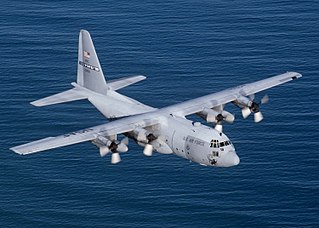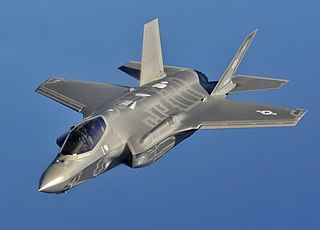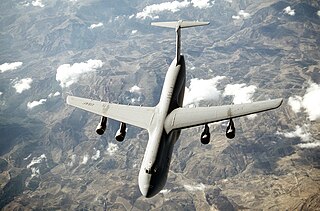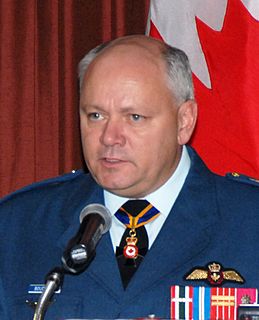
Area 51 is the common name of a highly classified United States Air Force (USAF) facility within the Nevada Test and Training Range. A remote detachment administered by Edwards Air Force Base, the facility is officially called Homey Airport or Groom Lake. Details of its operations are not made public, but the USAF says that it is an open training range, and it is commonly thought to support the development and testing of experimental aircraft and weapons systems. The USAF and CIA acquired the site in 1955, primarily for flight testing the Lockheed U-2 aircraft.

The Lockheed AC-130 gunship is a heavily armed, long-endurance, ground-attack variant of the C-130 Hercules transport, fixed-wing aircraft. It carries a wide array of ground-attack weapons that are integrated with sophisticated sensors, navigation, and fire-control systems. Unlike other modern military fixed-wing aircraft, the AC-130 relies on visual targeting. Because its large profile and low operating altitudes around 7,000 feet make it an easy target, its close air support missions are usually flown at night.

The Lockheed C-130 Hercules is an American four-engine turboprop military transport aircraft designed and built by Lockheed. Capable of using unprepared runways for takeoffs and landings, the C-130 was originally designed as a troop, medevac, and cargo transport aircraft. The versatile airframe has found uses in other roles, including as a gunship (AC-130), for airborne assault, search and rescue, scientific research support, weather reconnaissance, aerial refueling, maritime patrol, and aerial firefighting. It is now the main tactical airlifter for many military forces worldwide. More than 40 variants of the Hercules, including civilian versions marketed as the Lockheed L-100, operate in more than 60 nations.

The Lockheed F-117 Nighthawk is a retired American single-seat, twin-engine stealth attack aircraft developed by Lockheed's secretive Skunk Works division and operated by the United States Air Force (USAF). It was the first operational aircraft to be designed with stealth technology.

The Lockheed Martin F-35 Lightning II is an American family of single-seat, single-engine, all-weather stealth multirole combat aircraft that is intended to perform both air superiority and strike missions. It is also able to provide electronic warfare and intelligence, surveillance, and reconnaissance capabilities. Lockheed Martin is the prime F-35 contractor, with principal partners Northrop Grumman and BAE Systems. The aircraft has three main variants: the conventional takeoff and landing (CTOL) F-35A, the short take-off and vertical-landing (STOVL) F-35B, and the carrier-based (CV/CATOBAR) F-35C.

The Lockheed C-5 Galaxy is a large military transport aircraft designed and built by Lockheed, and now maintained and upgraded by its successor, Lockheed Martin. It provides the United States Air Force (USAF) with a heavy intercontinental-range strategic airlift capability, one that can carry outsized and oversized loads, including all air-certifiable cargo. The Galaxy has many similarities to the smaller Lockheed C-141 Starlifter and the later Boeing C-17 Globemaster III. The C-5 is among the largest military aircraft in the world.

The Lockheed P-3 Orion is a four-engined, turboprop anti-submarine and maritime surveillance aircraft developed for the United States Navy and introduced in the 1960s. Lockheed based it on the L-188 Electra commercial airliner. The aircraft is easily distinguished from the Electra by its distinctive tail stinger or "MAD" boom, used for the magnetic anomaly detection (MAD) of submarines.

The Lockheed Martin EC-130 series comprises several slightly different versions of the Lockheed C-130 Hercules that have been and continue to be operated by the U.S. Air Force and, until the 1990s, the U.S. Navy.

The Lockheed HC-130 is an extended-range, search and rescue (SAR)/combat search and rescue (CSAR) version of the C-130 Hercules military transport aircraft, with two different versions operated by two separate services in the U.S. armed forces.

Number 216 Squadron is a squadron of the Royal Air Force based at RAF Waddington, Lincolnshire, since reforming on 1 April 2020 and is tasked with testing future drone swarm technology. It had previously operated Lockheed TriStar K1, KC1 and C2s from RAF Brize Norton, Oxfordshire, between November 1984 and March 2014.

No. 487 (NZ) Squadron was a light bomber squadron established for service during the Second World War. It was a New Zealand squadron formed under Article XV of the Empire Air Training Plan. Although many of its flying personnel were largely drawn from the Royal New Zealand Air Force, the squadron served in Europe under the operational and administrative command of the Royal Air Force as part of Bomber Command. Formed in mid-1942, it operated the Lockheed Ventura and then the de Havilland Mosquito and took part in over 3,000 operational sorties before being disbanded at the end of the war in late 1945.

The 353rd Special Operations Wing is an operational unit of the United States Air Force Special Operations Command, stationed at Kadena Air Base, Japan.

GPS Block III consists of the first ten GPS III satellites, which will be used to keep the Navstar Global Positioning System operational. Lockheed Martin designed, developed and manufactured the GPS III Non-Flight Satellite Testbed (GNST) and all ten Block III satellites. The first satellite in the series was launched in December 2018. The tenth and final GPS Block III launch is projected in 2023.

The 193rd Special Operations Wing is a unit of the Pennsylvania Air National Guard, stationed at Harrisburg Air National Guard Base, Middletown, Pennsylvania. The wing is gained by the Commonwealth of Pennsylvania when in a "state" status, as well as by the United States Air Force and Air Force Special Operations Command in its Federal capacity as part of the Air National Guard. The wing was organized as a group, the 193rd Tactical Electronic Warfare Group. Although it has never been mobilized as a unit, most of its equipment and personnel have been individually called up to serve in Southeast Asia and in Desert Storm.

Ching Chuan Kang Air Base is a Republic of China Air Force (ROCAF) base located in Taichung, Taiwan. It is the home to the 3rd Tactical Fighter Wing, with three squadrons of AIDC F-CK-1 Ching-kuo fighter aircraft. It is also used by the army's airborne and special operations command.

The 21st Fighter Squadron is part of the 56th Operations Group at Luke Air Force Base, Arizona. It is a United States Air Force squadron that operates Taiwanese-owned General Dynamics F-16 Fighting Falcon aircraft conducting fighter and maintenance training for the pilots and maintainers of the Republic of China Air Force.

Orléans – Bricy Air Base is a French Air and Space Force (ALAE) base. The base is located approximately 6 miles (9.7 km) north-northwesst of Ingré near the city of Orléans; about 65 miles (105 km) south-southwest of Paris, France.

The 14th Weapons Squadron is a United States Air Force unit. It is assigned to the USAF Weapons School, stationed at Hurlburt Field, Florida.

The Lockheed MartinKC-130 is a family of the extended-range tanker version of the C-130 Hercules transport aircraft. The KC-130J is the latest variant operated by the United States Marine Corps (USMC), with 48 delivered out of 79 ordered. It replaced older KC-130F, KC-130R, and KC-130T variants for aerial refueling. USMC reserve unit, VMGR-452 operated 12 KC-130T aircraft until May 2021; this was the last USMC reserve unit that operated the legacy KC-130s, completing the corps' transition to the more advanced Super Hercules.

Lieutenant General Joseph Jacques Charles "Charlie" Bouchard is a retired Royal Canadian Air Force general. He has served as Commander of 1 Canadian Air Division / Canadian NORAD Region, the Deputy Commander of North American Aerospace Defense Command (NORAD) and Deputy Commander of Allied Joint Force Command Naples. On 25 March 2011, Bouchard was named Commander of the NATO military mission in Libya.




















